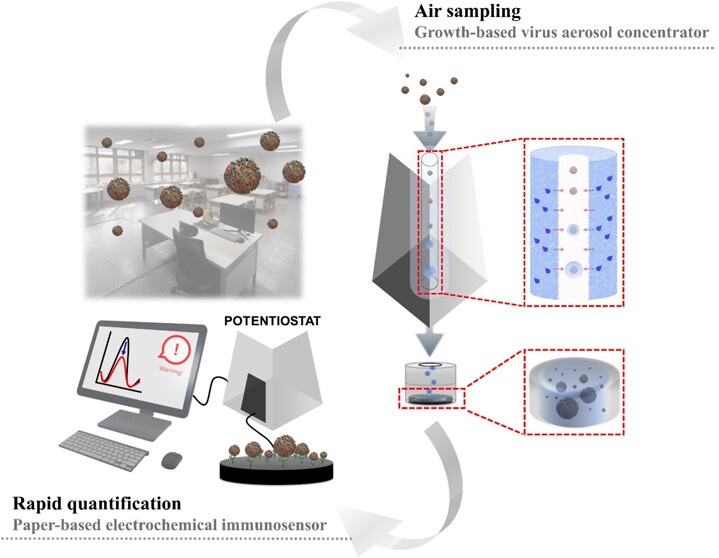Groundbreaking Technology Rapidly Detects Airborne Influenza Viruses
|
By HospiMedica International staff writers Posted on 10 Apr 2025 |

Influenza, caused by the influenza virus, poses a significant health risk, particularly in confined spaces. Now, a new, cutting-edge technology promises to enhance the early detection of airborne viruses like influenza and COVID-19, especially in environments such as hospitals.
Developed by researchers at UNIST (Ulsan, Republic of Korea), this innovative surveillance system can efficiently capture and analyze airborne viruses without causing any harm. The system works by drawing air into a device that condenses moisture onto virus particles, thereby capturing them for detection through paper-based immunosensors. Given that airborne viruses are incredibly small and lightweight, they are typically challenging to collect. However, by forming water droplets on the viral surface, the system increases the particles' size and weight, making them easier to capture. The device generates a high airflow, causing the virus-laden droplets to collide with the collection surface, rather than being carried along by the air current. Once the virus samples are gathered, they are transferred to an immunosensor, which provides results within 30 minutes. This detection method relies on the antigen-antibody interaction of proteins, specifically targeting hemagglutinin (HA) and nucleoprotein (NP) on the surface of the virus for accurate identification.
This breakthrough system significantly cuts down the time needed for virus detection, while also offering valuable insights into the infectious potential of the detected viruses. Unlike traditional PCR methods, which focus on identifying viral genetic material (DNA or RNA) and require expensive equipment and several hours for amplification, this new technology centers on detecting hemagglutinin proteins. These proteins are linked to the virus’s ability to infect, providing a more precise understanding of the risk level. As outlined in research published in Environmental Science & Technology, the system has effectively detected type-A influenza viruses, distinguishing it from conventional air sampling techniques used in epidemiological studies. In real-world testing conducted at an elementary school, the research team collected and analyzed 17 air samples from classrooms, hallways, and cafeterias, successfully identifying the influenza A virus (H1N1) in four cases. In contrast, traditional commercial aerosol sampling equipment did not detect any viruses in the same environments.
“This technology is not limited to influenza viruses; it has the potential to detect various respiratory viruses, including COVID-19,” said UNIST Professor Jaesung Jang who led the research. “With further research to enhance the system, we can greatly improve early infection monitoring and response in public spaces, hospitals, and schools.”
Related Links:
UNIST
Latest Critical Care News
- Mechanosensing-Based Approach Offers Promising Strategy to Treat Cardiovascular Fibrosis
- AI Interpretability Tool for Photographed ECG Images Offers Pixel-Level Precision
- AI-ECG Tools Can Identify Heart Muscle Weakness in Women Before Pregnancy
- AI Model Analyzes Patient Data to Diagnose Multiple Sclerosis With 90% Accuracy
- Magnetically Navigable Microparticles Enable Targeted Drug Delivery
- AI-Powered Algorithm Automates Analysis of Coronary Stents After Implantation
- New Stroke Risk Scoring System to Help Avoid Unnecessary Surgeries
- Wearable Device Tracks Individual Cells in Bloodstream in Real Time
- Drug Delivery System Uses Ultrasound-Activated Nanoparticles to Destroy Bacterial Biofilms
- New Potent Injectable Therapy Could Prevent Heart Failure After Heart Attack
- Hospital-Based System Combines AI and Genomic Surveillance to Quickly Detect Infectious Disease Outbreaks
- New Approach to Visualizing Blood Pressure Data Can Help Better Manage Hypertension Patients
- Breakthrough AI Technology Accurately Assesses Heart Failure Severity
- Smart Bandage Monitors Chronic Wounds in Human Patients
- AI Identifies Patients with Increased Lung Cancer Risk Up To 4 Months Earlier
- Next Gen Hemodynamic Monitoring Solution Provides AI-Driven Clinical Decision Support
Channels
Surgical Techniques
view channel
Bioprinted Aortas Offer New Hope for Vascular Repair
Current treatment options for severe cardiovascular diseases include using grafts made from a patient's own tissue (autologous) or synthetic materials. However, autologous grafts require invasive surgery... Read more
Early TAVR Intervention Reduces Cardiovascular Events in Asymptomatic Aortic Stenosis Patients
Each year, approximately 300,000 Americans are diagnosed with aortic stenosis (AS), a serious condition that results from the narrowing or blockage of the aortic valve in the heart. Two common treatments... Read more
New Procedure Found Safe and Effective for Patients Undergoing Transcatheter Mitral Valve Replacement
In the United States, approximately four million people suffer from mitral valve regurgitation, the most common type of heart valve disease. As an alternative to open-heart surgery, transcatheter mitral... Read morePatient Care
view channel
Portable Biosensor Platform to Reduce Hospital-Acquired Infections
Approximately 4 million patients in the European Union acquire healthcare-associated infections (HAIs) or nosocomial infections each year, with around 37,000 deaths directly resulting from these infections,... Read moreFirst-Of-Its-Kind Portable Germicidal Light Technology Disinfects High-Touch Clinical Surfaces in Seconds
Reducing healthcare-acquired infections (HAIs) remains a pressing issue within global healthcare systems. In the United States alone, 1.7 million patients contract HAIs annually, leading to approximately... Read more
Surgical Capacity Optimization Solution Helps Hospitals Boost OR Utilization
An innovative solution has the capability to transform surgical capacity utilization by targeting the root cause of surgical block time inefficiencies. Fujitsu Limited’s (Tokyo, Japan) Surgical Capacity... Read more
Game-Changing Innovation in Surgical Instrument Sterilization Significantly Improves OR Throughput
A groundbreaking innovation enables hospitals to significantly improve instrument processing time and throughput in operating rooms (ORs) and sterile processing departments. Turbett Surgical, Inc.... Read moreHealth IT
view channel
Printable Molecule-Selective Nanoparticles Enable Mass Production of Wearable Biosensors
The future of medicine is likely to focus on the personalization of healthcare—understanding exactly what an individual requires and delivering the appropriate combination of nutrients, metabolites, and... Read more
Smartwatches Could Detect Congestive Heart Failure
Diagnosing congestive heart failure (CHF) typically requires expensive and time-consuming imaging techniques like echocardiography, also known as cardiac ultrasound. Previously, detecting CHF by analyzing... Read moreBusiness
view channel
Expanded Collaboration to Transform OR Technology Through AI and Automation
The expansion of an existing collaboration between three leading companies aims to develop artificial intelligence (AI)-driven solutions for smart operating rooms with sophisticated monitoring and automation.... Read more
















